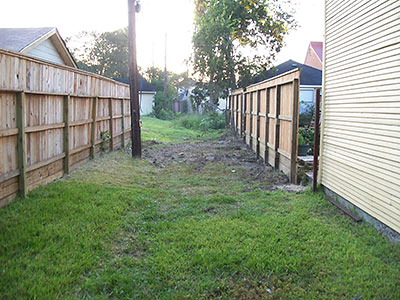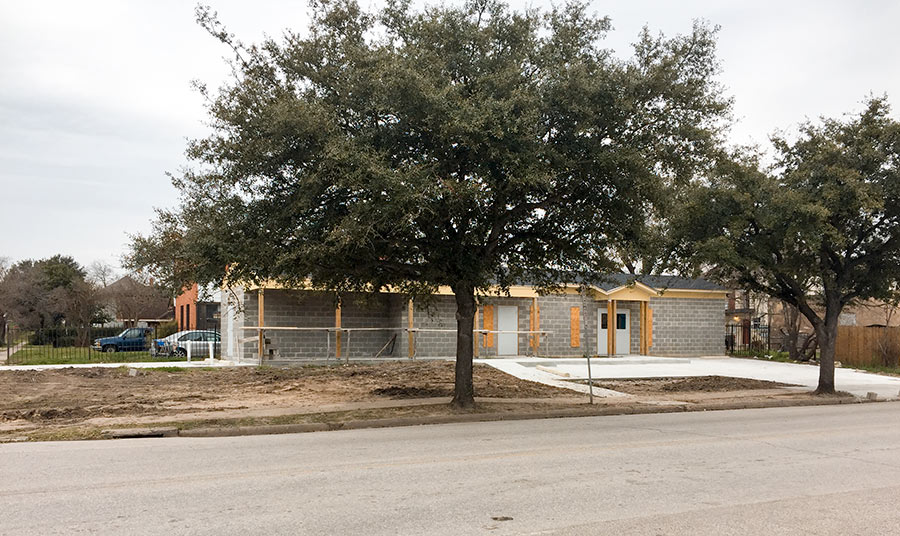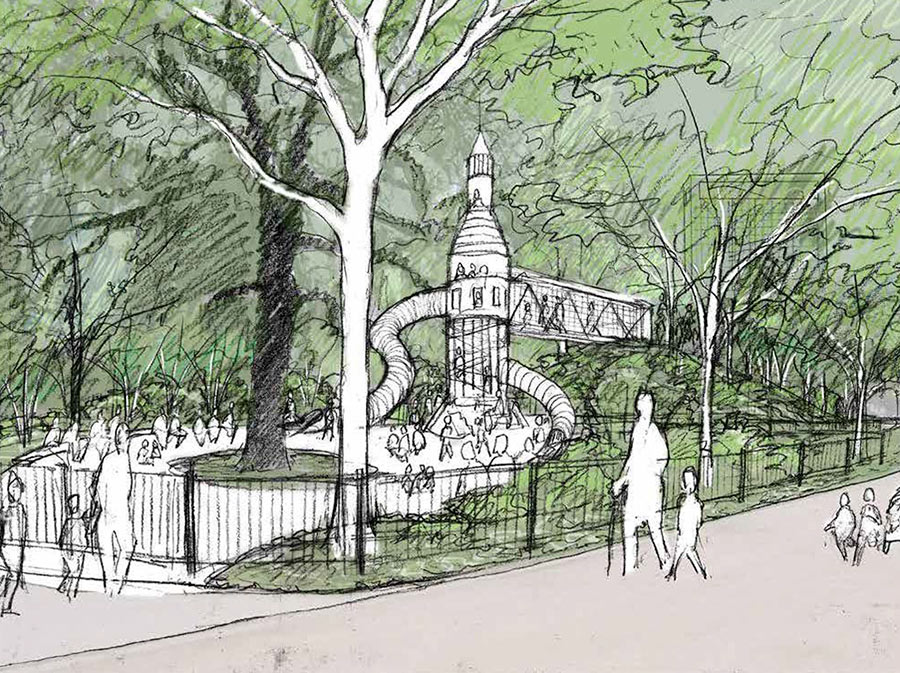
A reader writes:
There is an overgrown 12 foot wide city-owned “alley” behind my house in Riverside Terrace that due to weeds and trees is no longer navigable by anything larger than a “mini hydraulic excavator.” I know this because Centerpoint drove one back there when they put in my new gas meter in October.
My busy-body retired neighbor informs me that I am responsible for maintaining the alley by keeping the weeds and grass down, though when I look a few houses down in both directions from my house, I see a forest – and no one other than my neighbor complaining about it. So I quit mowing it 2 months ago, much to her chagrine. I’d like to treat it more like a green belt. Occasionally I’ll see a screech owl hunting back there during the late evening from its perch on my wooden fence. IMO the more trees, the better.
Am I really legally bound to mow back there? Mowing that small strip of grass would equate to another 2 pints of sweat lost, according to my experiences this past month.â€
Photo: Swamplot inbox





Actually, yes.
The City’s Code of Ordinances (10-451b) requires each property owner to maintain 14 feet in front of and behind his or her property line, this includes the city right-of-way. Just as you mow and maintain the grassy area in front of your home all the way to your curb or street, you are also responsible for mowing the side and back of your property if it extends to a curb, street, alley or ditch.
My grandmother turned hers into a nice vegetable garden for about 40 years, filled with domestic dewberries and watermelons.
I had a similar situation when I lived on Bonnie Brae. The neighbor at the end of the block treated it like his personal driveway and parking space, but much past the first two or three lots, it was thick as a jungle so it didnt bother me too much. Im sure the possums and other local fauna loved it.
I was intrigued by what digging out the area might reveal. Some neighbors further down had indeed converted their “space” into gardens. A nice bike trail would be nice, but the alleyway only runs the length our block. On the other side of 59, the alleyways are the only way in/out of some of the finer homes and terminate with the middle-block house. By the same token, anyone walking back there would be deemed suspcious.
It is possible that the city (based on a complaint) can mow it down for you because of the potential hazards of it being overgrown.
If the ally is Centerpoints, then they can go down it and chop every tree and mow it that blocks there path. They will do this if it is absolutely necessary to restore power are do maintenance and there are no other paths.
It is possible that one of your neighbors could end up mowing it for you.
I have a neighbor who fenced the alley into his back yard. It doesn’t bother me one bit.
We mow the alley but most of our neighbors do not. There are about 12 houses that back up to our alley and only 2 other neighbors help with the mowing. A tree fell across it about a year ago and its still there. I like the barrier because it keeps random people from driving back there.
I’d fence it in and make it part of my backyard. I’d make a wide opening gate on the either end that I can unlock to allow access if needed by the City, Centerpoint, AT&T or anyone else that might have legal access rights.
@EmilyM – Thanks for the specific reference to the City Code. I dug around further on there and found Section 40-342 where the city has some very stringent (and IMO unobtainable) requirements for bringing such an alley back to life. These include a petition signed by 75% of adjacent landowners and full assumption of all improvement/paving costs by those landowners. In an older nabe like RT, good luck with that!
In the photo above, it looks as if two people are backed up to the alley. How do they determine which is responsible for mowing? Both?
My lot, like most in The Houston Heights, backs up to an alley. I cleared all the dense growth when I moved in 10 years ago so I could drive through it when necessary. I keep it mowed just like the rest of my lawn but the neigbors to the other side of me do not so it is a constant battle to keep the wild growth and poison ivy from encroaching on the parts I mow. I’m ALWAYS battling the poison ivy :(
I only mow the half of the alley that immediately abuts my backyard. The people who live behind me never mow the other half. When the grass in the unkempt portion gets to be close to a foot tall, a nosy neighbor down the street intervenes and cuts it.
Poison ivy problems? One word – Roundup for Poison Ivy. OK, that’s 4 words. That stuff works.
Based on my experience in the Heights I would say that the requirements are definitely not unobtainable. Lots with alley access fetch a significant premium (10s of thousands) and so I would imagine the same is true for finished homes. The improvement costs appear to be generally no greater than bringing in a few truck loads of rock and spreading it out. This has resulted in several developers bringing alleys back to life. In one case I have even seen a storm drain laid down for half a blocks length of alley to solve a drainage issue.
Remember also that if you fence it in this can come back and bite you at selling time as that land does not technically belong to you.
The treatment of alleys was THE major issue for inner loop builders until the Historic thing came up. The alleys are public land so be careful about fencing in an alley. If nobody cares it’ll be okay until someone does care, at which point anyone can ask the City to make you take down the fence at your expense. This was setteld in court about 10 years ago and it cost some people a LOT of money when they refused to allow alley access.
As for improving the alley: it used to be as easy as putting down gravel but now it is MUCH more involved and expensive. I improved a 200′ (about 1/3 of a block) alley last year and the civil engineering cost about $12,000 and the improvement cost another $20,000. The City wants the alleys to conform to public road specifications. They don’t need to be paved but they do need to drain themselves and the rear 1/2 of the lots abuting them. Once they are imprived they are turned over to the City to maintain, which is why they have to be engineered and built to code.
This has caused big problems for builders because the first one who wants to use the alley has to bare all of the cost of improvement, any coming after get to benefit at no cost. That is why an improved alley add so much value to a lot. Older alleys that have been used for a long time as drives can be considered improved enough to use without all of the above, but it’s getting harder and harder to convince the City than an alley is good enough.
SCD,
You could have just had the gravel placed and compacted without going throughout all that trouble.
A civil engineer charging you $12,000 took you to the cleaners. And this is coming from a civil engineer.
The city does not have a gravel road standard and drainage is as simple as not forcing water to pond on existing properties by blocking it.
Having gravel just hauled there by the homeowners and spread without telling the city isn’t a big deal.
Well I guess I did it the illegal way because I paid Cherry demolition about $400 to dump a truck load of crushed concrete. I spread it myself with a metal rake and shovel. I “improved” about 150′ of alley with nothing but elbow grease. We already had pre-existing drainage issues in the alley and that condition still exists.
KJB,
You are correct, just adding gravel without telling the city is not a bid deal.
The big deal starts when one of your neighbors calls the city and tells them what you did.
Once the city is involved they want a plan and profile, 24″ drain pipe, and type “d” inlets. It gets expensive in a hurry.
In many cases they will require you to connect the 24″ RCP to the existing storm drain. This leads to having to build a new manhole for the connection.
The solution is simple. When neighbors call to complain about drainage the city simply needs to tell them to install landscape drains so that their property drains to the street in front. alley’s were never intended to be drains. The streets have always been intended to be drains.
For whatever reason the city just wont tell people this simple fact.
What kind of alley are you building?
A thin layer of gravel is no problem. And if the city comes, it’s very hard for them to pin it on someone. Just calling someone in for putting gravel on a public back alley won’t ruffle feathers at the city.
I’ve actually talked to CoH engineering about this, as we had some problems with water pooling in the alley behind our garage. Basically, the City will let you fill in holes/low spots with new material (in our case, there were a couple hundred s.f. of “holes”) , but if you want to resurface or re-grade the whole alley, it needs to be engineered to city specs.
So essentially a load of gravel and then spreading it out is really no big deal to the city.
The problems crop up when someone wants to build a new house or garage apartment utilizing the alley for access. I am aware of some cases where owners were caught by surprise regarding the city’s engineering requirements for the alleys.
Kjb,
to clarify I am speaking of the heights alleys.
The city enforces alley improvements with a passion in the heights
I live in the Heights and we were told the issue with alleys is drainage. Paving requires permits from the city. The permits require hiring an engineer. We were told that putting down gravel was fine as it does not normally affect drainage. That was what we were told when we called the city to inquire about permits. We put gravel down 2 years ago and have never heard any concerns from neighbors or the city.
KJB,
Do you have any experience with the alleys in Houston? What I paid was much less than most have had to pay. I know of more than 1 builder that was surprised by a $50,000 alley job. The City will generally allow you to add gravel to level out the surface, but if you want to use it for access and it has never been used, or improved, you have to do a plan and profile, topos and bring it to City specs bacuse when you are done it will be turned over to the City to maintain.
FYI: when the Heights, and most neighborhoods with alleys, was planned the lots actually sloped toward to the alleys. That changed sometime around the middle of the century when lots were graded to the streets. There are many lots that are original in their grading and still drain to the alley, so you are not supposed to raise the level of the alley or you could create a dam that floods those lots. When you do a plan and profil the engineeers have to calculate the drainage of the lots adjoining it so sometimes you have to put in very large drainage pipes to handle the water. You also may have to put in other types of drainage because the alleys are generally so low, and the streets that they intersect have been built up so much, that there is not enough fall to allow gravity to drain it. This is also why the alleys flood.
Yes,
I do have experience with alleys in the Heights area.
I’ve helped builders have access to alleys for driveways and garages without having to do improvements to alleys. There is no requirement that forces you essentially rebuild the alley. One of the reviewers tried to get us to do that. We decided to call higher ups in the engineering department to figure out what rule forces us to rebuild the alley. There isn’t any. The trick is know the rules and don’t bend over when they want you too. All the builder did after the project was built was add some gravel to reinforce the alley. Other existing neighbors were grateful since they used the alleys occasionally.
kjb: “One of the reviewers tried to get us to do that. We decided to call higher ups in the engineering department to figure out what rule forces us to rebuild the alley. There isn’t any. The trick is know the rules and don’t bend over when they want you too.”
This is a perfect example of why I have such a negative attitude about the Historical Districts and the “reviewers” people are going to be dealing with. I see poorer homeowners, who won’t have the knowledge or access to the right information, being taken advantage of. All because they don’t have the right “connections.”
This has nothing to do with “connections”.
Anybody can get a meeting with the guys we went to where the decision was ultimately made. It’s no different than asking to speak to a manager because an employee you are talking to isn’t helpful. The rules didn’t support what the reviewer wanted us to do. All we were doing is tying into an alley with a driveway. Per plat and easements, the lots had access. If there was tree or blockage in the middle of the alley, the builder would have removed them (which they were legally allowed to do).
kjb, you do have connections, you’re a knowledgeable pro in your field, managers know that and you get taken seriously by the higher-ups.
Do you think a lower-income, less educated small homeowner will get the same respect from a commission of “historic experts”? I just don’t think so.
If you think I can put a phone call into the city and then someone over there will quickly lift a finger to help me, you are living a dream world that I wish I was living.
No, but I bet you do get respected. You might not get instant results, but they pay attention to what you have to say.
I admit that I am partially basing this opinion on my experiences with HCAD. I’ve been treated pretty disrespectful by the appraisers more than once, as I look young for my age (I’m heading into my late 40s and let me tell you, this ain’t my first rodeo). And that was with sales comps, photographs and unlike appraisal numbers in hand. I thought one guy was going to pat me on my wittle hand and send me on my way.
Anyone who thinks the good old boy mindset isn’t still prevalent in Government entities is deluded, and or poor.
KJB,
I’m not doing anything in the Heights antime soon, at least until this is figured out, but I’ll look for you when I do. The problem with these committees and new regulations is that there are too many ways for them to be interpreted and everyone has an opinion on how to read them. When I did that alley it was early in the city’s process of figuring out how to do it so I may have been a victim of early, and strict, interpretation. I know a lot of people that spent a lot of money on alleys around the same time but maybe, hoepfully, they have eased off an those onerous requirements. I think that’s what will happen with these new Historic Guidelines.
A former chief code administrator for the City of Houston once told me that the building codes are ‘one percent white, one percent black, and 98 percent gray’. The treatment of alleys has definitely fallen into the 98 percent category. Meanwhile, the new and improved preservation ordinance may break new ground by being 100 percent gray. Even under the current (former?) ordinance, we have had the experience of having one historical staff member ‘love’ a design which was submitted, while another wrote a multi-page e-mail excoriating it. Fortunately a majority of the Historical and Archaeological Commission agreed with us, and our client received the COA. Lots and lots of gray area….
The City doesn’t require a super highway in the alley, just drainage. Be a good neighbor and put drainage in if you want to use the alley so the whole block doesn’t have flooding issues.
Amy,
You speak with reason but sadly the city does not. Drainage means 24″ concrete pipe, it costs $30 per foot installed. This is a city ordinance. It is non-negotiable.
An 8″ plastic pipe would work at a fraction of the cost, but that is not permitted per the city ordinance. look it up.
It would be fair for the whole block if alley plans were presented along with the construction plans. We have one permitted alley in our area that has proper drainage and gravel and its working out fine. The Houston Builders Association should work with the City if they think costs are unfair. Instead, those who don’t like the costs and choose to avoid Code leave neighbors with messy flooded alleys and the buyer with a situation.
Amy,
The “Houston Builders Association” has worked with the city regarding alleys for years. There has been good outcomes, and bad ones. Google it and beyond…knock yourself out.
Most search data has been removed by the City to conserve space and rational thought,
Alleys are a potentially expensive mess…end or story,
Chester is right about the potentially expensive mess in the alleys. Due to my blocked driveway view from the SUV parked in the bootleg parking pad next door, I was going to use alley access myself. But when one of the neighbors on the corner had some other neighbors red tagged for parking their garbage cans at the end of the alley and for dumping gravel in the alley, I decided the alley was a hassle. When your house covers the entire lot, easement parking can get you into trouble with the neighbors and the City.
The alley ordinance could be changed just like the historical ordinance. I could be forced to pony up to install expensive drains if I use the alley. No thank you.
Does anyone know anything about alleys that don’t go through? The 15′ ROW behind my house dead ends into the Fugate St ROW “ditch”, so it can’t be a public alley because it doesn’t connect two streets…
Think the city would sell it to me?